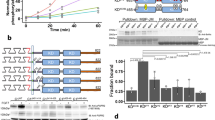Abstract
STIMULATION of certain receptor tyrosine kinases results in the tyrosine phosphorylation and activation of phospholipase Cγ(PLCγ), an enzyme that catalyses the hydrolysis of phosphatidylinositol (Ptdlns)1–8. This hydrolysis generates diacylglycerol and free inositol phosphate, which in turn activate protein kinase C and increase intracellular Ca2+, respectively. PLCγ physically associates with activated receptor tyrosine kinases, suggesting that it is a substrate for direct phosphorylation by these kinases7–10. Here we report that a fibroblast growth factor (FGF) receptor with a single point mutation at residue 766 replacing tyrosine with phenylalanine fails to associate with PLCγ in response to FGF. This mutant receptor also failed to mediate Ptdlns hydrolysis and Ca2+ mobilization after FGF stimulation. However, the mutant receptor phosphorylated itself and several other cellular proteins, and it mediated mitogenesis in response to FGF. These findings show that a point mutation in the FGF receptor selectively eliminates activation of PLCγ and that neither Ca2+ mobilization nor Ptdlns hydrolysis are required for FGF-induced mitogenesis.
Similar content being viewed by others
References
Wahl, M. I. et al. Molec. cell. Biol. 9, 2934–2943 (1989).
Burgess, W. H. Molec. cell. Biol. 10, 4770–4777 (1990).
Nishibe, S. et al. Science 250, 1253–1256 (1990).
Sultzman, L., Ellis, C., Lin, L-L., Pawson, T. & Knopf, J. Molec. cell. Biol. 11, 2018–2025 (1991).
Vetter, M. L., Martin-Zanca, D., Parada, L. F., Bishop, M. J. & Kaplan, D. R. Proc. natn. Acad. Sci. U.S.A. 88, 5650–5654 (1991).
Kim, H-K. et al. Cell 65, 435–441 (1991).
Margolis, B. et al. Cell 57, 1101–1107 (1989).
Meisenhelder, J., Suh, P-G., Rhee, S. G. & Hunter, T. Cell 57, 1109–1122 (1989).
Morrison, D. K., Kaplan, D. R., Rhee, S. G. & Williams, L. T. Molec. cell. Biol. 10, 2359–2366 (1990).
Kumjian, D. A., Barnstein, A., Rhee, S. G. & Daniel, T. O. J. biol. Chem. 266, 3973–3980 (1991).
Mohammadi, M. et al. Molec. cell. Bio. 11, 5068–5078 (1991).
Fantyl, W. J. et al. Cell 69, 413–423 (1992).
Escobedo, J. A., Kaplan, D. R., Kavanaugh, W. M., Turck, C. W. & Williams, L. T. Molec. cell. Biol. 11, 1125–1132 (1991).
Johnson, D. E., Lee, P. L., Lu, J. & Williams, L. T. Molec. cell. Biol. 10, 4728–4736 (1991).
Olwin, B. B. & Hauschka, S. D. J. cell. Biochem. 39, 443–454 (1989).
Brown, K. D., Blakeley, D. M. & Brigstock, D. R. FEBS Lett. 247, 227–231 (1989).
Huang, C-L., Takenawa, T. & Ives, H. E. J. biol. Chem. 266, 4045–4048 (1991).
Cochet, C., Gill, G. N., Meisenhelder, J., Cooper, J. A. & Hunter, T. J. biol. Chem. 259, 2553–2558 (1984).
Friedman, B. A., van Amsterdam, J., Fujiki, H. & Rosner, M. R. Proc. natn. Acad. Sci. U.S.A. 86, 812–816 (1989).
Rotin, D. et al. EMBO J. 11, 559–567 (1992).
Vega, Q. et al. Molec. cell. Biol. 12, 128–135 (1992).
Wells, A. et al. Science 247, 962–964 (1990).
Decker, S. J., Alexander, C. & Habib, T. J. biol. Chem. 267, 1104–1108 (1992).
Chen, W. S. et al. Cell 59, 33–43 (1989).
Margolis, B. et al. EMBO J. 9, 4375–4380 (1990).
Downing, J. R. et al. EMBO J. 8, 3345–3350. (1989).
Margolis, B. et al. Science 248, 607–610 (1990).
Cuadrado, A. & Molloy, C. J. Molec. cell. Biol. 10, 6069–6072 (1990).
Goldschmidt-Clermont, P. J., Kim, J. W., Machesky, L. M., Rhee, S. G. & Pollard, T. D. Science 251, 1231–1233 (1991).
Maslanski, J. A., Leshko, L. A. & Busa, W. B. Science 256, 243–245 (1992).
Author information
Authors and Affiliations
Rights and permissions
About this article
Cite this article
Peters, K., Marie, J., Wilson, E. et al. Point mutation of an FGF receptor abolishes phosphatidylinositol turnover and Ca2+ flux but not mitogenesis. Nature 358, 678–681 (1992). https://doi.org/10.1038/358678a0
Received:
Accepted:
Issue Date:
DOI: https://doi.org/10.1038/358678a0
- Springer Nature Limited
This article is cited by
-
Metabolic Messengers: fibroblast growth factor 1
Nature Metabolism (2022)
-
New insights into the role of fibroblast growth factors in Alzheimer’s disease
Molecular Biology Reports (2022)
-
The beginning of the era of precision medicine for gastric cancer with fibroblast growth factor receptor 2 aberration
Gastric Cancer (2021)
-
FGF18–FGFR2 signaling triggers the activation of c-Jun–YAP1 axis to promote carcinogenesis in a subgroup of gastric cancer patients and indicates translational potential
Oncogene (2020)
-
Targeting the heparin-binding domain of fibroblast growth factor receptor 1 as a potential cancer therapy
Molecular Cancer (2015)





